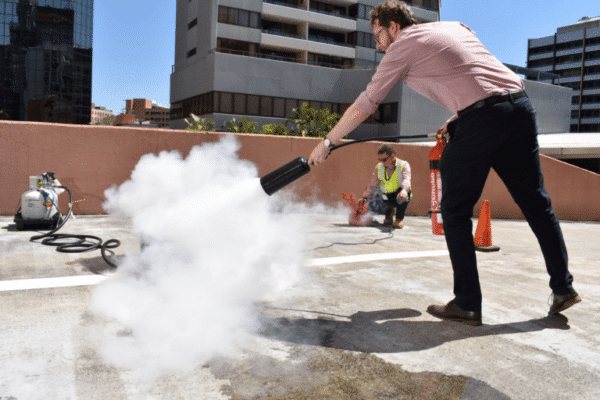The Evolution of Fire Extinguisher Training
For facility managers, it is important to ensure that occupants and Emergency Control Organisation (ECO) members are properly trained in using fire extinguishers to respond to small fires. However, the way this training is delivered has evolved over the years, from basic classroom learning to virtual reality experiences.
In this article, we go through the ways that fire extinguisher training has evolved and how you can best provide your occupants and ECO members the practical experience and knowledge to handle small workplace fires before they get out of control.
Table of Contents:
- The history of fire extinguishers
- What is fire extinguisher training?
- How fire extinguisher training has evolved over the years
- How to find the right fire extinguisher training for your business
1. THE HISTORY OF FIRE EXTINGUISHERS
A fire extinguisher is an active fire protection device that facilities use to extinguish or control small fire emergencies. Although they are not intended for large out-of-control fire emergencies, they are an imperative piece of equipment in making sure small fires do not turn into these large-scale emergencies.
The first patent of the fire extinguisher was created in 1723 by Ambrose Godrey in England. Before the patent was made, fires used to be put out using buckets of what we believe was simply water.
The patented fire extinguisher was a far simpler version of the fire extinguisher that we know of today; it consisted of a cask of fire-extinguishing liquid that also contained a pewter chamber of gunpowder. The pewter chamber was connected with a system of fuses which were ignited, exploding the gunpowder and scattering the solution.
Despite its very limited abilities, this first patent was a huge step forward from the firefighting methods that were used prior to its invention.
The stored pressure fire extinguisher that we know of today, first came about in 1818 when it was patented by British Captain George William Manby. It consisted of a copper vessel that contained 13.6 litres of potassium carbonate solution contained within compressed air.
Since then, many types of fire extinguishers have become available to deal with different types of fires. These fire extinguisher types include:
- Water
- Dry Chemical Powder
- Carbon Dioxide
- Foam
- Wet Chemical
- Class D Dry Powder
- Vaporising Liquid
- Sapphire MRI
For a more detailed guide on these fire extinguisher types, you can download our visual handbook for free.
2. WHAT IS FIRE EXTINGUISHER TRAINING?
Fire extinguisher training equips your staff, occupants, and ECO members with the practical skills, experience, & knowledge to deal with small workplace fires quickly and safely – before they get out of control.
First 5 Minutes’ fire extinguisher training includes:
- The different types of fire.
- The types of portable fire-fighting equipment found in the workplace.
- How to use equipment effectively.
- The safety procedures involved in dealing with small fires.
When enquiring about fire extinguisher training, it is important to ensure the training provided can be tailored to reflect bespoke Emergency Management Plans and your facility type. Otherwise, the training performed may not help you with ensuring your emergency compliance in accordance with Australian Standard 3745.
Delivered by highly experienced and qualified experts, First 5 Minutes’ fire extinguisher training is designed to prepare your occupants and ECO members for fighting small fires whilst also ensuring your emergency compliance is met.
3. How FIRE EXTINGUISHER TRAINING HAS EVOLVED OVER THE YEARS
Fire extinguisher training has generally had its roots in the typical classroom learning style. An expert will deliver the theory related to operating a fire extinguisher to a classroom of occupants, ECO members and other facility members so that they know how to operate the device as effectively as possible.
Over time however, several alternate learning methods have developed due to advances in new technologies. These learning methods include:
Self-Paced Online Learning
When learning in a classroom environment participants may find the time allotted to the training may not suit their schedules, their concentration wanes during long training periods, they’re unable to repeat any content that they may have questions about, and more.
Self-paced online learning was developed with these individuals in mind, providing them a flexible way to complete their fire extinguisher training whilst still maintaining compliance. Learning is completed using an online learning platform, which can be accessed at any time through any device.
VR Simulation
Are you confident that in the event of a fire, your facility would know the exact location of the fire extinguishers and how to effectively use them? Virtual reality fire extinguisher training enables hands-on training for scenarios that are inherently unsafe and not possible due to environment or regulatory constraints.
This ‘fully-immersive’ experience teaches occupants to identify the existence of a fire, decide on fire extinguisher type and then use it to extinguish the fire in an appropriate manner – all whilst remaining completely safe.
VR simulated training also contains a broad range of other benefits including safer training outcomes without the risk of fire damage to a premises, a wider range of exercise scenarios, more occupants experiencing training at once, no limitations due to facility space and more.
Real Gas-Fired (LPG) Fire Tray
Classroom learning can only go so far. When it comes to getting a feel for an extinguisher and knowing how to properly handle it, real gas-fired fire trays are a useful tool that creates a small controllable fire to extinguish.
This method of training is great for facilities that have safe areas that it can be performed in – as it gives the most realistic experience of fire extinguishing there is outside of a real emergency.
4. HOW TO FIND THE RIGHT FIRE EXTINGUISHER TRAINING FOR YOUR BUSINESS
Determining the best fire extinguisher training for your facility can be a confusing process. The thought process can be broken down into the following key considerations:
How many occupants will be completing the training?
- If you have a larger ECO team at your facility, it can be more difficult to properly complete VR or Real Gas-Fired Fire Tray training options. Larger teams generally will get the most use out of self-paced online learning or the typical classroom approach.
Are the schedules of my occupants aligned? How much time do I have available for training at a given time?
- When your team, occupants or ECO team have a varied schedule that doesn’t align well, self-paced online learning options generally offer the flexibility required to get training completed effectively.
- Likewise, if your occupants don’t have much time to complete training in one session, self-paced online training is a perfect solution to allow greater flexibility in completing training.
Does my facility have safe spaces to conduct real life training?
- If your facility has a safe space to conduct fire extinguisher training, real gas-fired fire tray training provides an invaluable training experience to ensure effective handling of small fire emergencies.

